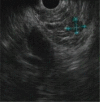Safety and Efficacy of EUS-Guided Ethanol Ablation for Treating Small Solid Pancreatic Neoplasm
- PMID: 26825894
- PMCID: PMC5291564
- DOI: 10.1097/MD.0000000000002538
Safety and Efficacy of EUS-Guided Ethanol Ablation for Treating Small Solid Pancreatic Neoplasm
Abstract
The strategy for treating small borderline malignant pancreatic neoplasms--such as neuroendocrine tumor (NET) and solid pseudopapillary neoplasm (SPN)--is surgical resection. However, pancreatic resection of these lesions still causes significant morbidity. We evaluated the safety and efficacy of EUS-guided ethanol ablation to treat small solid pancreatic neoplasms. A total of 8 patients with small borderline malignant pancreatic neoplasms and co-morbidities who refused surgery were included. We identified 2 cases of nonfunctioning NET, 3 cases of insulinomas, 1 case of gastrinoma, and 2 cases of SPN. EUS-guided ethanol ablation was performed, and treatment outcomes were assessed with clinical symptom, hormone assay, and imaging study. The mean tumor diameter was 15 mm (range, 7-29 mm), and the median volume of injected ethanol was 2.8 mL (range, 1.2-10.5 mL). There was 1 severe acute pancreatitis after EUS-guided ethanol ablation with 20-gauge CPN needle. During follow-up (median 16.5 months), 6 patients achieved treatment success; however, 2 patients (1 nonfunctioning NET and 1 SPN) still had persistent tumors. The patient with persistent SPN underwent surgical resection and the histopathological results showed peripancreatic infiltration with perineural invasion. Among 6 patients who achieved initial treatment success, 1 patient experienced tumor recurrence within 15 months and underwent repeated EUS-guided ethanol ablation. In conclusion, EUS-guided ethanol ablation therapy is a promising option for patients with small solid pancreatic neoplasm. Multiple sessions or surgical interventions may be required if there is a recurrent or persistent mass, and procedure-related adverse events must be carefully monitored.
Conflict of interest statement
The authors have no funding and conflicts of interest to disclose.
Figures




Similar articles
-
Outcomes after endoscopic ultrasound-guided ethanol-lipiodol ablation of small pancreatic neuroendocrine tumors.Dig Endosc. 2018 Sep;30(5):652-658. doi: 10.1111/den.13058. Epub 2018 Apr 19. Dig Endosc. 2018. PMID: 29575213
-
Endoscopic ultrasound-guided radiofrequency ablation for management of benign solid pancreatic tumors.Endoscopy. 2018 Nov;50(11):1099-1104. doi: 10.1055/a-0583-8387. Epub 2018 May 4. Endoscopy. 2018. PMID: 29727904
-
Endoscopic ultrasound-guided ethanol ablation therapy for tumors.World J Gastroenterol. 2013 Jun 14;19(22):3397-403. doi: 10.3748/wjg.v19.i22.3397. World J Gastroenterol. 2013. PMID: 23801831 Free PMC article. Review.
-
Successful EUS-guided ethanol ablation of insulinoma, four-year follow-up. Case report and literature review.Endokrynol Pol. 2017;68(4):472-479. doi: 10.5603/EP.2017.0053. Endokrynol Pol. 2017. PMID: 28819950 Review.
-
EUS-guided ethanol ablation of insulinomas: case series and literature review.Medicine (Baltimore). 2014 Sep;93(14):e85. doi: 10.1097/MD.0000000000000085. Medicine (Baltimore). 2014. PMID: 25255024 Free PMC article. Review.
Cited by
-
B-mode and contrast-enhancement characteristics of small nonincidental neuroendocrine pancreatic tumors.Endosc Ultrasound. 2017 Jan-Feb;6(1):49-54. doi: 10.4103/2303-9027.200213. Endosc Ultrasound. 2017. PMID: 28218201 Free PMC article.
-
Non-surgical ablative therapies for inoperable benign insulinoma.J Endocrinol Invest. 2018 Feb;41(2):153-162. doi: 10.1007/s40618-017-0738-3. Epub 2017 Jul 28. J Endocrinol Invest. 2018. PMID: 28755102 Review.
-
The role of microwave ablation in management of functioning pancreatic neuroendocrine tumors.Gland Surg. 2019 Dec;8(6):766-772. doi: 10.21037/gs.2019.12.07. Gland Surg. 2019. PMID: 32042685 Free PMC article.
-
Current status of the role of endoscopy in evaluation and management of gastrointestinal and pancreatic neuroendocrine tumors.Indian J Gastroenterol. 2023 Apr;42(2):158-172. doi: 10.1007/s12664-023-01362-8. Epub 2023 May 2. Indian J Gastroenterol. 2023. PMID: 37129761 Review.
-
Role of endoscopic ultrasound in the diagnosis and local ablative therapy of pancreatic neuroendocrine tumors.Korean J Intern Med. 2025 Mar;40(2):170-180. doi: 10.3904/kjim.2024.293. Epub 2025 Feb 25. Korean J Intern Med. 2025. PMID: 39995262 Free PMC article. Review.
References
-
- Cheema A, Weber J, Strosberg JR. Incidental detection of pancreatic neuroendocrine tumors: an analysis of incidence and outcomes. Ann Surg Oncol 2012; 19:2932–2936. - PubMed
-
- Gaujoux S, Partelli S, Maire F, et al. Observational study of natural history of small sporadic nonfunctioning pancreatic neuroendocrine tumors. J Clin Endocrinol Metab 2013; 98:4784–4789. - PubMed
-
- Santini D, Poli F, Lega S. Solid-papillary tumors of the pancreas: histopathology. JOP 2006; 7:131–136. - PubMed
MeSH terms
Substances
LinkOut - more resources
Full Text Sources
Other Literature Sources
Medical

